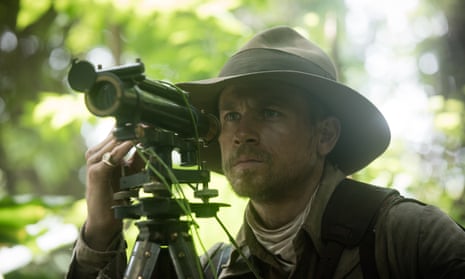How does one make an a strapping adventure about colonial pursuits without either coming across as an imperialist or going overboard with “virtue signaling”?
Earlier this year Colombian director Ciro Guerra released one of the best films of the year, Embrace of the Serpent, which told a tale of early 20th century European explorers in the Amazon, from their guide’s point of view. James Gray’s The Lost City of Z, which shares a similar setting, isn’t quite so revolutionary, but escapes the net of the evil European/noble savage dialectic by focusing on a driven lead character drawn to a higher, nobler purpose than fame and fortune.
It doesn’t start out that way. When we meet Major Percy Fawcett (Charlie Hunnam), a British officer billeted in Cork, Ireland, he is respected, but only to a degree. One one upper crust man fumphers to another “he’s been rather unfortunate in his choice of ancestors.” He looks dashing in a dress uniform, but still feels naked due to his lack of medals.
Opportunity to restore his family name comes in 1906, when the Royal Geographical Society decides to send someone to make a definitive border map between Bolivia and Brazil. The two nations are involved in a skirmish, which has the potential to cause havoc with the price of rubber. A neutral party could maybe calm things down. Oh, and it would also be for the betterment of science and all mankind, let’s not forget that.
Fawcett accepts, and leaves behind his wife Nina (Sienna Miller) and young son. Were this an older film Nina wouldn’t be given a second thought, but as Fawcett makes his three trips over two decades, the sacrifices the adventurer’s family makes for the cause of exploration becomes, almost without warning, the central theme of the film.
There are three trips because, during that first one, Fawcett stumbles upon some physical evidence (and some native hearsay) of a civilization lost to time in the “green desert” of Amazonia. This predates the western discovery of Machu Picchu, so the thought of a lost city is swatted away like a child’s talk of El Dorado, but once Fawcett is convinced, he’s found his life’s purpose. His presentation to his peers at the RGS is a raucous barrage of old men tut-tutting (the best this Yank’s seen since they used to show Prime Minister’s Questions on late night television) but it gets him patronage from a benefactor with delusions of glory named James Murray (Angus Macfadyen).
Naturally, he’s the member of the second expedition who’s first to crack under harsh conditions, nearly sending everyone (including a quite amusing Robert Pattinson as Fawcett’s explorer bro) to their deaths.
Much will be said about Gray’s cinematic craft (as is often the case when a director works with cinematographer Darius Khondji) but beneath the slow roll down the river pierced by arrows from unseen, defensive natives, there’s a fascinating, mercurial screenplay that offers just enough to keep you journeying for more insight. Gray’s script (based on a nonfiction book by David Grann) swerves away from the expected tropes of determined madness in the jungle.
This is not Apocalypse Now or Aguirre, The Wrath of God. The tone is more like Robert Bolt, who followed men in compelling natural settings with the screenplays for Lawrence of Arabia, The Mission and The Bounty. (Indeed, an early match cut may be a deliberate nod to Lawrence.) This is an exploration into the morality of a driven individual, and how setbacks (like, I don’t know, the First World War) shouldn’t get you down.
With The Immigrant James Gray evolved into a type of film-maker determined the claim that “they don’t make ‘em like that anymore.” Even with a relatively modest budget (there aren’t any sweeping vistas with hundreds of extras) his intimate portraits have a wider scope than most blockbusters. Its final shot, which one-ups Gray’s punch-to-the-heart ending from The Immigrant, is a rich statement about wonder, beauty and loss; a small bit of perfection that all who regularly attend the cinema are on a seemingly fruitless quest to find.
